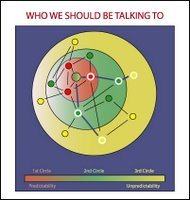But, be careful whose advice you follow! Here are two contrasting pieces of advice emanating from Chicago.
First, Betsy Hart of the Chicago Sun Times relates her experience...
It used to make me crazy when people would invite my then-husband and me over to dinner, only to discover that another couple we'd never met had been included because the hosts thought we would ''just love these folks.''
Whether we did or not, we'd have to spend the whole night making small talk and asking, ''So, how old are your kids?'' I was at a stage in life where I didn't want to learn how old someone's kids were. I just wanted to relax with people I already knew.
Just being with people you know is easy and safe -- no effort, nor risk required. But it gets you a dull network -- everyone knows everyone else, everyone agrees with everyone else, and everyone hears what is going on at the same time. This is OK for friendship networks, but not good for business networks, nor for those of us who like a little variety in our friends and opportunities in our networks.
Ron Burt, Professor of Sociology and Strategy at the University of Chicago, is one of the top experts on social capital in the world. His advice is different. He suggests we focus on those who are different, rather than on those we are already connected to.
They have broader access to information because of their diverse contacts. That means they are more often aware of new opportunities, and aware earlier than their peers.
Below is a diagram from Ron's work that shows the difference in the two types of networks. James has chosen the easy redundant strategy, while Robert has chosen the more difficult diverse contacts strategy. As Ron goes on to explain in this short article [PDF], it is Robert who has the advantage because of his network structure. Robert weaves a better network from the same starting point as James -- he is a network entrepreneur.
Enjoy a productive New Year in your entrepreneurial network!
UPDATE: Here is an excellent article on building business networks from the Harvard Business Review [PDF]. Though this article focuses on corporate managers, the advice is useful for those working in the not-for-profit sector and for community builders. Take note of their advice on the network change required when moving from being a manager to being a leader.
Notice how the HBR avice in building a strategic network meshes with Burt's advice on building a diverse network.


